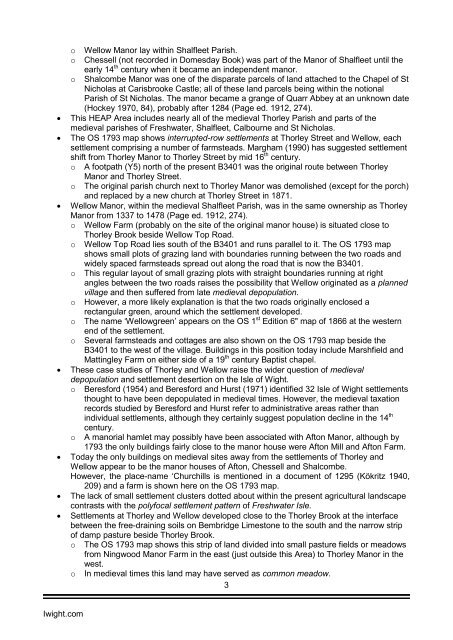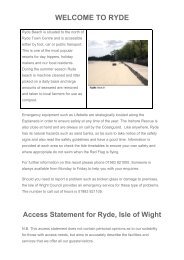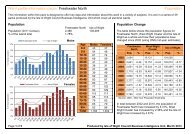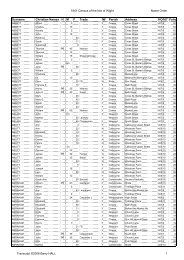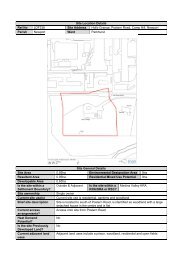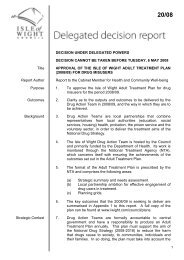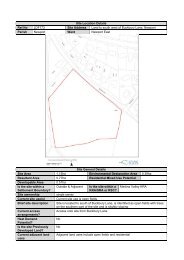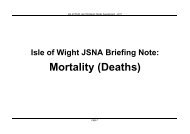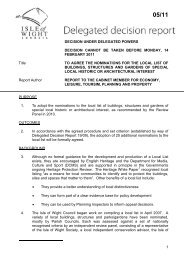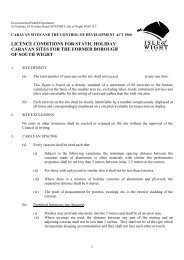Thorley Wellow Plain HEAP - Isle of Wight Council
Thorley Wellow Plain HEAP - Isle of Wight Council
Thorley Wellow Plain HEAP - Isle of Wight Council
- No tags were found...
You also want an ePaper? Increase the reach of your titles
YUMPU automatically turns print PDFs into web optimized ePapers that Google loves.
ooo<strong>Wellow</strong> Manor lay within Shalfleet Parish.Chessell (not recorded in Domesday Book) was part <strong>of</strong> the Manor <strong>of</strong> Shalfleet until theearly 14 th century when it became an independent manor.Shalcombe Manor was one <strong>of</strong> the disparate parcels <strong>of</strong> land attached to the Chapel <strong>of</strong> StNicholas at Carisbrooke Castle; all <strong>of</strong> these land parcels being within the notionalParish <strong>of</strong> St Nicholas. The manor became a grange <strong>of</strong> Quarr Abbey at an unknown date(Hockey 1970, 84), probably after 1284 (Page ed. 1912, 274).• This <strong>HEAP</strong> Area includes nearly all <strong>of</strong> the medieval <strong>Thorley</strong> Parish and parts <strong>of</strong> themedieval parishes <strong>of</strong> Freshwater, Shalfleet, Calbourne and St Nicholas.• The OS 1793 map shows interrupted-row settlements at <strong>Thorley</strong> Street and <strong>Wellow</strong>, eachsettlement comprising a number <strong>of</strong> farmsteads. Margham (1990) has suggested settlementshift from <strong>Thorley</strong> Manor to <strong>Thorley</strong> Street by mid 16 th century.o A footpath (Y5) north <strong>of</strong> the present B3401 was the original route between <strong>Thorley</strong>Manor and <strong>Thorley</strong> Street.o The original parish church next to <strong>Thorley</strong> Manor was demolished (except for the porch)and replaced by a new church at <strong>Thorley</strong> Street in 1871.• <strong>Wellow</strong> Manor, within the medieval Shalfleet Parish, was in the same ownership as <strong>Thorley</strong>Manor from 1337 to 1478 (Page ed. 1912, 274).o <strong>Wellow</strong> Farm (probably on the site <strong>of</strong> the original manor house) is situated close to<strong>Thorley</strong> Brook beside <strong>Wellow</strong> Top Road.o <strong>Wellow</strong> Top Road lies south <strong>of</strong> the B3401 and runs parallel to it. The OS 1793 mapshows small plots <strong>of</strong> grazing land with boundaries running between the two roads andwidely spaced farmsteads spread out along the road that is now the B3401.oThis regular layout <strong>of</strong> small grazing plots with straight boundaries running at rightangles between the two roads raises the possibility that <strong>Wellow</strong> originated as a plannedvillage and then suffered from late medieval depopulation.o However, a more likely explanation is that the two roads originally enclosed arectangular green, around which the settlement developed.o The name ‘<strong>Wellow</strong>green’ appears on the OS 1 st Edition 6" map <strong>of</strong> 1866 at the westernend <strong>of</strong> the settlement.o Several farmsteads and cottages are also shown on the OS 1793 map beside theB3401 to the west <strong>of</strong> the village. Buildings in this position today include Marshfield andMattingley Farm on either side <strong>of</strong> a 19 th century Baptist chapel.• These case studies <strong>of</strong> <strong>Thorley</strong> and <strong>Wellow</strong> raise the wider question <strong>of</strong> medievaldepopulation and settlement desertion on the <strong>Isle</strong> <strong>of</strong> <strong>Wight</strong>.o Beresford (1954) and Beresford and Hurst (1971) identified 32 <strong>Isle</strong> <strong>of</strong> <strong>Wight</strong> settlementsthought to have been depopulated in medieval times. However, the medieval taxationrecords studied by Beresford and Hurst refer to administrative areas rather thanindividual settlements, although they certainly suggest population decline in the 14 thcentury.oA manorial hamlet may possibly have been associated with Afton Manor, although by1793 the only buildings fairly close to the manor house were Afton Mill and Afton Farm.• Today the only buildings on medieval sites away from the settlements <strong>of</strong> <strong>Thorley</strong> and<strong>Wellow</strong> appear to be the manor houses <strong>of</strong> Afton, Chessell and Shalcombe.However, the place-name ‘Churchills is mentioned in a document <strong>of</strong> 1295 (Kökritz 1940,209) and a farm is shown here on the OS 1793 map.• The lack <strong>of</strong> small settlement clusters dotted about within the present agricultural landscapecontrasts with the polyfocal settlement pattern <strong>of</strong> Freshwater <strong>Isle</strong>.• Settlements at <strong>Thorley</strong> and <strong>Wellow</strong> developed close to the <strong>Thorley</strong> Brook at the interfacebetween the free-draining soils on Bembridge Limestone to the south and the narrow strip<strong>of</strong> damp pasture beside <strong>Thorley</strong> Brook.o The OS 1793 map shows this strip <strong>of</strong> land divided into small pasture fields or meadowsfrom Ningwood Manor Farm in the east (just outside this Area) to <strong>Thorley</strong> Manor in thewest.o In medieval times this land may have served as common meadow.3Iwight.com


